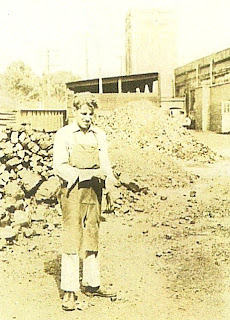For the past several days, we have been celebrating the centennial anniversary of 5317 Lowell Avenue. Clifton and Hilah Drake Wheeler built their dream home in 1912. For decades the couple, created inspiring art pieces in the gallery room designed into the plan of the house. Newspaper accounts from the early twentieth century describe the room bulging with art from floor to ceiling.
 |
| Spring by Clifton Wheeler |
Clifton Wheeler (1883-1953) grew up in Mooresville, Indiana. His father had planned for him to take over the family flour mill business, but he had other dreams. An inspirational aunt invited him to live with her in Indianapolis on the weekends during his teen years so that he could take classes from noted artist and Irvingtonian, William Forsyth. The young man generally sat for lessons on Saturdays. Eventually, he made his way to New York City to study under Robert Henri and Kenneth Hayes Miller, and finally to Europe where he painted under the direction of William Merritt Chase. While in Europe, he observed, critiqued, and recreated the classics. He also developed his own style. In 1910, William Merritt Chase gave young Wheeler the award for being his best student. In that same year, while touring Europe, he met fellow art student Hilah Drake. He would earn his second prize when she said
yes to his proposal of marriage.
 |
| Mural at Shortridge High School, Indianapolis, c.1914 |
.jpg) |
| Clifton Wheeler murals restored in 2006 at School Number 54 (3150 East 10th, Indianapolis), 1921 |
Once settled in Indiana, the couple moved to Irvington in 1912 to be near other artists and to enjoy the beauty of Pleasant Run stream and Ellenberger Woods. Many of Mr. Wheeler's works feature Indiana scenes. He was frequently called upon to paint murals around the state. Several of his works are still in existence including those in several schools, universities, hospitals, and at the Circle Theater.
He earned a living by teaching in his private studio on Lowell Avenue; at the John Herron Art Institute; and at Shortridge High School. The Wheelers traveled the country for inspiration and spent time painting in the Catskills and Rockies. Mr. Wheeler exhibited all over the state and country as well. He was renown during his lifetime. Hundreds of his paintings and sketches remain in private and public collections all over the United States.
 |
| Young Leaves by Clifton Wheeler |
 |
| Winter Woodland by Clifton Wheeler |
 |
| Up Fall Creek by Clifton Wheeler |
It appears that the Wheelers remained close throughout their lifetime. They had one child named Hilah Mary. Mr. Wheeler continued to paint until his cancer would not allow him to do so. He died at the age of 69 in 1953. His companion, wife, and fellow artist, Hilah Drake Wheeler, outlived him by several years. She passed away at the age of 92 in 1970.
 |
| Clifton and Hilah Drake Wheeler Home, May, 1913 |
One hundred years later, the home has been proudly restored. The Wheelers would be happy to know that their shady lot and stuccoed home looks much as it did in 1912. To learn more about the Wheelers click on the link below. The historic images are courtesy of Michele and Bruce Oertel.


















.jpg)









+Summer+1939.jpg)






.jpg)






.jpg)





.jpg)
.jpg)
.jpg)


